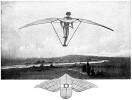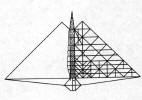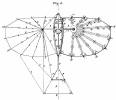|
1800 1801 1802 1803 1804 1805
1806 1807 1808 1809
1810 1811 1812 1813 1814 1815 1816 1817 1818 1819
1820 1821 1822 1823 1824 1825 1826 1827 1828 1829
1830 1831 1832 1833 1834 1835 1836 1837 1838 1839
1840 1841 1842 1843 1844 1845 1846 1847 1848 1849
1850 1851 1852 1853 1854 1855 1856 1857 1858 1859
1860 1861 1862 1863 1864 1865 1866 1867 1868 1869
1870 1871 1872 1873 1874 1875 1876 1877 1878 1879
1880 1881 1882 1883 1884 1885 1886 1887 1888 1889
1890 1891 1892 1893 1894 1895 1896 1897 1898 1899
Hang Glider History Timeline EnterData+
Send your favorite timed item to
timeline@hanggliderhistory.com
Notes: Link prefix with "g" is a generalized Google search. Prefix with a "w" is a leading Wikipedia file on topic. |
Linknife |
| |
1800
EnterData+
[_top_] |
|
|
1801 |
| |
1802
|
| |
|
| |
1803 |
- Model monoplane Cayley glider sketch. Elliptical leading edge. Keel beam. Tail adjustable. Main wing angle of attack adjuster. Sometimes this is called the first airplane. Glider with a hung mass...hang glider model!
-
-
|
1804 |
- Lateral stability from dihedral in wing: George Cayley
|
1805 |
|
Andre-Guillaume Resnier
"General Resnier of Goue, the Frenchman who in 1806 at the age of 77 became the
world's first hang glider pilot by launching himself from the ramparts of
Angouleme, some 250 ft (76 m) above the River Charente.
His first flight rewarded him with a ducking in the Charente and his second with
a broken leg, but the point had been made. Others had simply managed to fall
slower with their machines than without them, but Resnier was almost able to
control the course of his second flight - and it was a flight, not just a fall." Ref>
BMAA
"In
1806, its first test of flapping flight success was not crowned. Springing
parapet of Beaulieu, it jumps into space by agitating the wings in wire covered
with waxed taffeta. It does nothing but descend rock in rock.
The second attempt is worth to him a bath forced in the Charente. Left the
bridge, high 5 meters, connecting the district Saint-Cybard to Angouleme, it
falls into water at the end of 50 meters from vol.
Finally its third and last test are a success. He traverses 300 meters by
springing top of the ramparts of the city and breaks only one leg on arrival.
He dies in Angouleme on February 2nd 1811. " Ref>
Andre-Guillaume Resnier
"Français
André-Guillaume Resnier.
Cet ingénieur a réalisé en
1801 un vol avec une aile de sa fabrication : en partant du haut de la tour
Ladent, il a réussi à planer 300 m et à franchir la Charente."
High resolution photo
3.5 mb. >> PlaqueResnier
|
1806 |
- More lift from curved wings: George Cayley.
|
1807 |
| |
1808 |
|
|
1809
EnterData+
[_top_] |
|
|
1810
EnterData+
[_top_] |
| |
1811 |
- Born: William Samuel Henson
|
1812
EnterData+
[_top_] |
| |
1813 |
| |
1814 |
| |
1815 |
| |
1816 |
| |
1817 |
| |
1818 |
| |
1819 |
| |
1820 |
| |
1821 |
| |
1822 |
| |
1823 |
| |
1824 |
| |
1825 |
-
 George Pocock founded kite-buggying! Notice also that a powered cart could launch a manned kite....hang glider. Charvolant. wGP1 George Pocock founded kite-buggying! Notice also that a powered cart could launch a manned kite....hang glider. Charvolant. wGP1 |
1826 |
| |
1827 |
| |
1828 |
| |
1829 |
| |
1830 |
| |
1831 |
- Octave Alexandre Chanute (18 February 1832 - November 23, 1910). Octave Chanute. gOAC1 wOAC1
|
1832 |
| |
1833 |
| |
1834 |
| |
1835 |
| |
1836 |
| |
1837 |
| |
1838 |
| |
1839 |
| |
1840 |
| |
1841 |
| [_top_] |
1842 |
|
|
1843 |
| |
1844 |
| |
|
| |
1845 |
| |
1846 |
| |
1847 |
-
 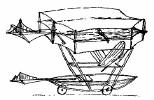 Cayley sketch of triplane (literature has it still as "monoplane") glider. Cayley sketch of triplane (literature has it still as "monoplane") glider.
-
|
1848 |
| |
1849 |
| |
1850 |
| |
1851 |
- Saturday, September 25, 1852: Sir George Cayley's Fig. 1 and Fig. 2 are published on the cover of Mechanics' Magazine, No. 1520: "SIR GEORGE CAYLEY'S GOVERNABLE PARACHUTES" .Pilot is suspended beneath flexible framed ribbed sail wing. Tail and a governing tail. Keel beam. Tricycled for land rolling. gGP1
|
1852
EnterData+
[_top_]
|
|
|
1853
EnterData+
[_top_] |
| |
1854 |
| |
1855 |
- wiki: Jean-Marie Le Bris
- Glider L'Albatros artificiel towed by a horse at a beach. He reportedly achieved a height of 100 meters, over a distance of 200 meters.
-
|
1856 |
|
|
1857 |
- Born John Joseph Montgomery wJJM gJJM_1 died: 1911.
|
1858
|
| |
1859 |
| |
1860 |
| |
1861 |
| |
1862 |
| [_top_] |
1863 |
| |
1864 |
- Louis Pierre Mouillard, flight of 138 ft., differential left/right wing control (this later sparked the interest of the Wright Brothers.
|
1865 |
- In 1866, the Aeronautical Society of Great Britain was founded.
- Royal Aeronautical Society of Great Britain received Frank Wenham's paper; advantages of long thin wings are discussed.
- ""Jan Wnęk (b. 1828 in Kaczówka - July 10, 1869 in Odporyszów, Austria-Hungary).
Jan Wnęk was an aviation pioneer; He was illiterate but known to be very intelligent. Trained as a carpenter, this Polish peasant had a keen sense of detail and was also able to restore paintings. Under the encouragement of the Roman Catholic Father Stanislaw Morgenstern, Wnęk became a prolific wood and stone sculptor for churches and cemeteries in Kraków and Odporyszów. The angels he sculpted are described to 'have have wings of exceptional beauty.' He also possessed an instinctive talent for mechanics and improved some contemporary agricultural machinery. He also acted in some village plays.
Jan Wnęk is remembered in Poland as an early aviation pioneer. He was self-taught and could only count on his knowledge about nature based on the observation of bird flight and on his own builder and carver skills. He noted that some soaring birds made use of rising air currents in facilitating climb and identified the optimal weather conditions for his flights. He also spent considerable time (years) studying a dead duck's wing and observing how live birds manage their wings and tail for controlled flight.
Wnęk built several wing models and although he did not understand the aerodynamics of lift, he mimicked the upper curvature of a bird's wing.[citation needed] He tested his weighted models by throwing them by hand. In 1866 he started construction of an ash wood wing 'skeleton', which he covered with linen impregnated with varnish. After several months of work he completed construction and he named his glider "Loty" (Flyer). Jan Wnęk was firmly strapped to the glider by the chest and hips and controlled his glider by twisting the wing's trailing edge via strings attached to stirrups at his feet.[1][2] Wnęk managed his first short controlled flights in June of that same year from a small hill. After several flights, some adjustments and learning his glider behavior, Wnęk felt confident enough to ask for authorization from the Odporyszow village church priest -Stanisław Morgenstern- to build a special ramp on top of the church tower to launch from. The tower stood 45 m high and was located on top of a 50 m hill, making a 95 m (311 ft) high launch above the valley below.
On late June of 1866, Wnęk timed his 'big flight' to coincide with an upcoming Pentecost church celebration. It is reported that huge crowds came to church celebrations and also to purchase goods from shops and nearby town markets. The summer breeze must have been perfect as he launched for a flawless flight of substantial distance -probably aided by a prevailing thermal updraft- quoted as 1800 meters (about 1 mile). [3][4]
Church records indicate that Jan Wnęk made several public flights between 1866 - 1869 especially during religious festivals, carnivals and New Year celebrations.[citation needed] His fame spread to nearby villages and was said that 'he was either blessed or had dealings with the Devil.'
During the Pentecost Carnival held in May 16, 1869 at Odporyszow, Wnęk's did his final flight that ended in a tragic fall. An assistant, Michal Sowinski, was reported to be implicated in his death, in one fashion or another. He died a few weeks later at age 41, leaving a wife -Marianna Ciomborówna- and three children. His flying activities spanned about four years in time and, although his flights preceded Otto Lilienthal's by 25 years, Wnęk left no known written records or drawings, thus having no impact on aviation progress.
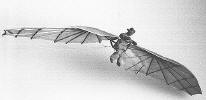 The fact is that there is no description of the glider and the presented model and control feature (if any) are speculations. But there does seem to be reason to believe that Wnęk may have made at least a few true glides in his machine. Oral descriptions of these events were transferred from one generation to the next throughout the whole region. Recently, Professor Tadeusz Seweryn, former director of the Kraków Museum of Ethnography [4], claims that he has unearthed some church records with descriptions of Jan Wnęk's activities. These have so far, not been available for verification."" ==> Nov. 15, 2007 status of a Wiki. wJW1 The fact is that there is no description of the glider and the presented model and control feature (if any) are speculations. But there does seem to be reason to believe that Wnęk may have made at least a few true glides in his machine. Oral descriptions of these events were transferred from one generation to the next throughout the whole region. Recently, Professor Tadeusz Seweryn, former director of the Kraków Museum of Ethnography [4], claims that he has unearthed some church records with descriptions of Jan Wnęk's activities. These have so far, not been available for verification."" ==> Nov. 15, 2007 status of a Wiki. wJW1
- Speculation model of Jan Wnęk's glider is shown for click through.
|
1866
Jan Wnęk

|
|
|
1867
|
| |
1868 |
| |
1869 |
| |
1870 |
- Frank Wenham, airfoil studies and confirmation of high aspect ratio as a key to lift. Wind tunnel (perhaps world's first) built by Wenham and John Browning was used for careful measurements.
|
1871 |
| |
1872 |
| |
1873 |
| |
1874 |
|
|
1875 |
| |
1876 |
|
FRANK BAENETT
U. S. Patent: 190730
Filing date:
Mar 12, 1877
Of course, if the engine stopped, one would want to be able to glide. And the pilot was hanging beneath the wing.

|
1877
Toys form youth; toys cover the esteem of adults who otherwise may be derided by the public. The drive for flight seeps into parenting, toys, play, dreaming. Toys and aeromodelling lay foundations for larger aircraft and hang gliders.
Inventions and mechanical art is gifted to the next generation often through toys that really function and work at a smaller scale than manned versions.
An adult designing an aircraft may little remember being imprinted with certain mechanical arts that remain available to designers.
|
| |
1878 |

X K KITE
JOHN THOMPSON
U.S. Patent number: 225306 The collapsible and foldable wing using flexible sail material indicates that tight stowing of a air-used wing was in the minds of those playing with the wind.
Filing date: Aug 11, 1879
Such concerns would reach into the hearts and minds of aeroplane and hang glider designers. Otto thought about these foldability things for his wings.
|
1879
EnterData+
[_top_] |
| |
1880 |
| Must visit for flexible wing, battened, bowspirt, tensioned leading edge: http://tinyurl.com/BreareyPATENTnoticeart |
1880 |
|
Inventor:
SIMON E. KELLY |
1881
EnterData+
[_top_] |
| |
1882 |
- John J. Montgomery flight ???
- August 28, 1883, John Joseph Montgomery controlled modern glider flight, Otay Mesa, near San Diego, California. 1gJJM w1JJM
- Louis Pierre Mouillard, L'Empire de L'Air, published in France in 1881, reprinted by the Smithsonian Institution in English in 1893 as The Empire Of The Air. LPM1 [ ]
|
1883
|
| EnterData + |
1884 |
| EnterData + |
1885 |
| EnterData + |
1886 |
| EnterData + |
1887 |
- William Samuel Henson, death year. EnterData +
|
1888
|
|
|
1889 |
| |
1890 |
- Otto Lilienthal: OL1 gOL2 wOL3 OL4 OL5 OL6 and Gustav L. and crew. Derwitzer Glider: wOLDG gOLDG Museum MOTph1891 Sixteen hang gliders? 2000 flights?
- Experiments in Aerodynamics by Samuel Pierpont Langley
 [Rotating spreader bar for kites that use flexible wings for tight stow and portability. This tactic would be used by NASA in the Paresev 1B Rogallo-wing using delta hanging-pilot kite-glider to set the scene for sport hang gliders in the upper third of the 1900s. Barry Palmer would use such on his Rogallo-winged trikes. Others in the standard Rogallo-winged hang glider manufacturing realm would use this same art for folding the spreader tube to make hang glider car-toppable and hand-carriable. Perhaps have a hats off to George S. Crosby?] [Rotating spreader bar for kites that use flexible wings for tight stow and portability. This tactic would be used by NASA in the Paresev 1B Rogallo-wing using delta hanging-pilot kite-glider to set the scene for sport hang gliders in the upper third of the 1900s. Barry Palmer would use such on his Rogallo-winged trikes. Others in the standard Rogallo-winged hang glider manufacturing realm would use this same art for folding the spreader tube to make hang glider car-toppable and hand-carriable. Perhaps have a hats off to George S. Crosby?]
George S. Crosby
Patent number: 487471
Filing date: Dec 14, 1891
|
1891
EnterData+
[_top_] |
|
|
1892
EnterData+
[_top_]
|
- Maihöhe-Rhinow-Glider. "Convertible" or collapsibility strongly present in a hang glider. (See above museum) MOTph1893
- "Kleiner Schlagflügelapparat" Lilienthal 1893 [Replica by Stephan Nitsch 1988 - Museum Anklam]
|
1893
EnterData+
[_top_]
|
- Carl Bates born on January 27, 1894.
- "Seiler's glider" (See above museum)
- "Modell Lambert" (See above museum)
- "Normal Glider" (See above museum)
- Sturmflügel-Modell (Storm Wing Model) 1894 (See above museum) [_top_]
- "Normal-Segelapparat" Lilienthal 1894 [1. Replica by Stephan Nitsch 1993 - Museum Anklam and 2. Replica by Stephan Nitsch 2004 - privately held]
- Waldo Waterman was born. gWW1
-
|
1894
EnterData+
[_top_]
|
|
1895
EnterData+
[_top_]
|
- MOTph1896
- On August 2, 1896, Robert W. Wood flew hang glider under Otto Lilienthal's
direction. See
nomination
here. Double-decker.
- The "King" dies from injuries from hang glider accident: Monday August 10, 1896.
Double-decker.
-
- Octave Chanute's Multiple-Wing Glider - "First Form" - 1896
- Chanute flew a Lilienthal hang glider and then his own movable-wing aircraft on June 22. [[2007: When we have a low-mass wing above us and we are weighing ourselves at 200 lbs and are hung from the wing that weighs 50 lbs...and we press the airframe to move or let the airframe adjust itself relative to our hanging mass, then we are employing Chanute controlwing technology; later see Spratt developing such. ]]
- Lilienthal-type Soaring Machine Built By Augustus M. Herring - Dune Park, Indiana - 1896
- Patent Drawing For The Chanute-Herring Glider Three-Surface Powered Machine - 1896
- Aeronautical Manual edited by James Means, 1896
|
1896
EnterData+
[_top_]
|
|
|
??[ ] |
|
|
1897
EnterData+
[_top_] |
EnterData +
- Carl Bates built and flew a monoplane hang glider towed by a horse.
-
http://www.spicerweb.org/chanute/glid_exp.aspx Chanute give important
article.
GLIDING EXPERIMENTS.
An ADDRESS* by OCTAVE CHANUTE, C. E., Mem. W. S. E.
(* Illustrated by lantern slides.)
Delivered 20th of October, 1897.
With remarks by Augustus Herring.
Published in the
Journal of the Western Society of Engineers, Vol.2, 1897. XX. |
1898 |
- Carl Bates built a Chanute biplane hang glider against parental objections.
- "Pilcher was fatally injured when his fourth machine, the Hawk, crashed after many successful flights. This glider is now preserved in the Museum of Flight (East Lothian)." [tail structural challenge] d. Oct. 2, 1899.
- Wright brothers begin to think seriously about the problem of flight.
- Pilcher Triplane Replica
2003 at Cranfield, UK ...photos taken by Tony Prentice |
1899 |

